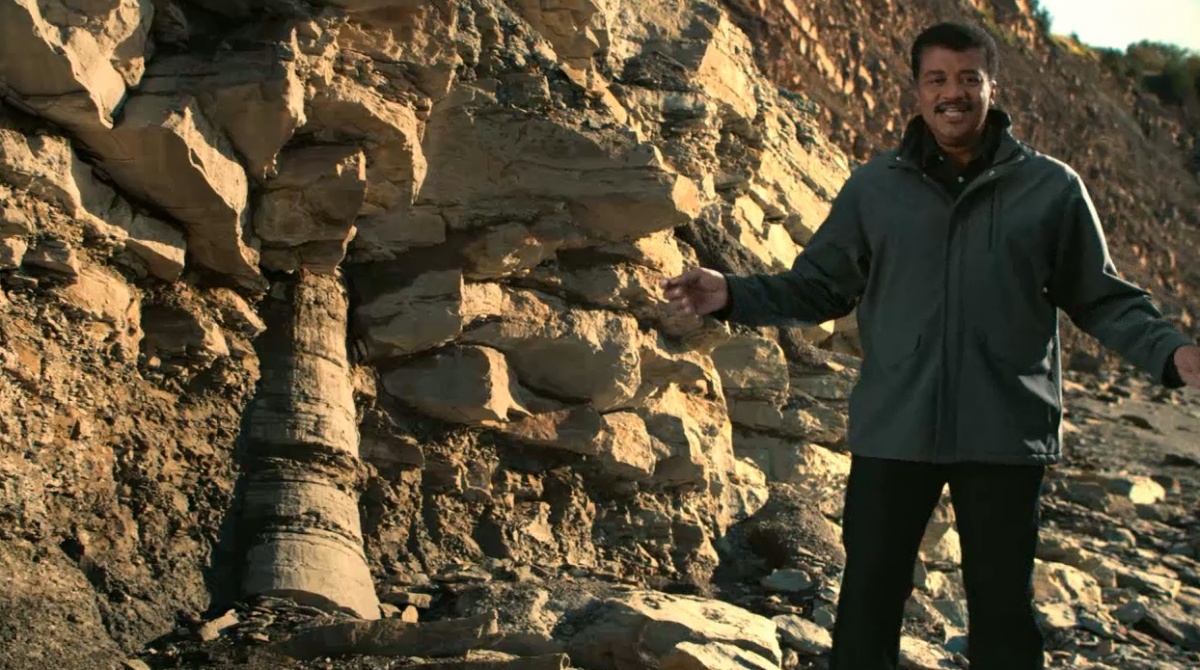This week’s Cosmos episode, “The Lost Worlds of Planet Earth,” was an extraordinary tour of geologic ideas, exposing television audiences to fascinating events most had probably never heard of. Neil deGrasse Tyson’s fact-rich explanations enlightened and informed even as they entertained the eye with dramatic visualizations.

“Lost Worlds” talked about the development of plate tectonics, Wegener, Milankovitch cycles, and the mass extinctions that have punctuated the history of life. These are red meat topics for geology. The show even spent considerable time on the Permian extinction, which is my favorite mass extinction (I’m not sure what it says about me that I have a favorite mass extinction). “The Lost Worlds of Planet Earth” had great information combined with clear explanations—this was science communication at its best.
So, of course, creationists hated it.
It didn’t take long for the Discovery Institute to inveigh against Neil deGrasse Tyson for daring to explain science in public. Tyson’s “sermon about climate change” involved such “hard-edged ideology” and “extreme environmental catastrophism” that, the DI warned, the episode should come with “viewer advisories.” (How such a warning might sound: “The following program contains science and facts that may not be suitable for younger audiences. Viewer discretion is advised.”)
According to the DI, this episode was “one part illuminating discussion” and “one part fanciful, highly speculative narrative” mixed with another part “rigid ideology disguised as the assured results of scientific research.” That’s a lot of parts. But all this would fine, the piece went on, if instead of lumping them together, Neil deGrasse Tyson had instead made the parts of the episode “clearly distinguishable, like a marble rye.”
Regulations stipulate that any reference to a marble rye must set up a Seinfeld joke, but I’m not getting it. Perhaps I’ll wait for a table at a Chinese restaurant while I think about it, but first I have to find the car I’ve lost in a parking garage.
Because Tyson talked about Wegener’s difficulties promoting his radical idea of continental drift against a resistant scientific community, DI's piece noted that Wegener was “one of the great scientific dissenters of the 20th century” and he died while a “‘denier’ of the established scientific consensus.”

Well, not quite. The word “denier” is misused and very out of place here. Denialism involves holding to or rejecting ideas even in the face of overwhelming evidence to the contrary. It’s not just ignorance—it’s a willful, stubborn, emotional refusal to acknowledge the obvious, like a child thinking that repeatedly screaming “No!” will somehow elicit a different result. That doesn’t really describe Wegener at all, who quite ably provided good, obvious evidence for his ideas. Had he not perished at the ripe old age of 50, he might have lived to see his ideas become the foundational theory of geology.
Tyson’s descriptions of ecological collapse during the Permian extinction gave the DI reason to proclaim,
If anything is obvious, it is that man had nothing to do with these events in the distant geologic past, and nothing that extreme is happening now.
The flawed inference here is that because the Permian extinction was not caused by people, therefore modern climate change cannot be caused by people either. Huh? How did we get there?
Rather, Tyson’s dramatic exposition about the ecological conditions during the Permian extinction gives us useful perspective. True, things now are nowhere near as bad as they were at the end of the Permian, but if non-human processes can create such a hellish world, what humans are doing now also has the potential to effect dramatic changes. Maybe not Permian-level changes, but there are several lesser also-rans for the title of The Great Dying.
Not to be outdone in this outrage over public science, Answers in Genesis, which runs the Creation Museum in Kentucky, declaimed against Neil deGrasse Tyson this way:
This episode of Cosmos offers a lot of beautiful graphics and special effects, but in the end it should be lumped with fairy tales like Tinker Bell or Shrek.
This piece asserted that Tyson’s “circular reasoning” and “unverifiable worldview-based assumptions” have blinded him to an astonishing conclusion:
[Noah’s] Flood and its aftermath provided the explanations for the majority of the phenomena described in this Cosmos episode.
Wait, are they talking about the movie or the book? (Some people always say the book is better, but I don’t know, that Russell Crowe is a pretty good actor.)
The Permian extinction described by Tyson was dismissed as a “speculative, mythological saga.” Answers in Genesis declares that in light of Flood geology, there “was no Permian mass extinction” and the “fossil record is instead primarily a record of the rapid burial of organisms during and soon after the global Flood.” Uh huh.
Then Answers in Genesis went where I knew they would go the moment I saw Tyson standing nears those cliffs in Nova Scotia: “polystrate” fossils. This word refers to a fossil that seemingly cuts across multiple layers of sediment, in seeming defiance of normal geologic processes. Creationists love “polystrate” fossils, because they argue such fossils support rapid, catastrophic burial during Noah’s Flood. AiG noted:
Curiously, Tyson briefly points out a vertical tree fossil spanning several sedimentary layers… Polystrate tree fossils are a major problem for evolutionists, as trees should not be able to remain undecayed and upright for millions of years until fossilized and buried.
Except that, of course, it’s pretty easy for a mild flood to half-bury a tree, killing it. Later, when the tree is fossilized, that ordinary flood deposit layer seems to have a tree stuck in it. No special events required, no “major problem for evolutionists,” no worldwide Flood. In fact, if you go to the Mammoth Hot Springs region of Yellowstone today, you can see scores of dead trees half-buried in travertine—ready made “polystrate” fossils.
What is it about Cosmos that so infuriates creationists? This episode covered topics I teach in introductory geology courses; do they hate me just for talking about these things? It reminds me of Mencken’s definition of Puritans as people possessed by the haunting fear that someone somewhere is having fun. So many people are so very upset that someone somewhere might be learning about the wonderful discoveries of science. We can only hope that Neil deGrasse Tyson’s great work in Cosmos continues to open minds and raise scientific literacy.
